An In-Depth Guide on the Dedicated Teams: Concept, Pros and Cons
Updated 17 Dec 2022
14 Min
2769 Views
Remote work is on the rise these days. The IT industry has been one of the pioneers in distributing work between remote teams. For that reason, it’s now one of the largest industries making use of outsourcing.
Entrepreneurs hire outsourced developers to accelerate the development, save money, and attract new talents faster. The dedicated team model is a great fit for many companies.
The dedicated team model is a “jack-of-all-trades” in terms of outsourcing. You can hire a dedicated team when you need to:
- Find software developers to build your idea
- Outsource a side project to someone and take the load off the core team
- Build a product and stay within your budget
Dedicated teams are great for both small startups and large companies. Over the years, more and more businesses catch the outsourcing wave:
- The overall IT services market share is estimated to be $992B in 2020
- Software outsourcing market share is 92.5 billion, which is around 10% of the overall IT services market
- 41% of companies have outsourced software development in 2020
In this post, you’ll learn what makes a dedicated team model so popular, how it can help your business, and when it’s better to hire dedicated teams.
What Is a Dedicated Team?
Before diving into outsourcing details, it’s important to clear up with the whole concept. What does a dedicated team mean? A dedicated team model is an approach where clients hire a team of developers for their projects. It’s usually a team managed from the customer side. Still, some companies offer hiring a project manager from their side.
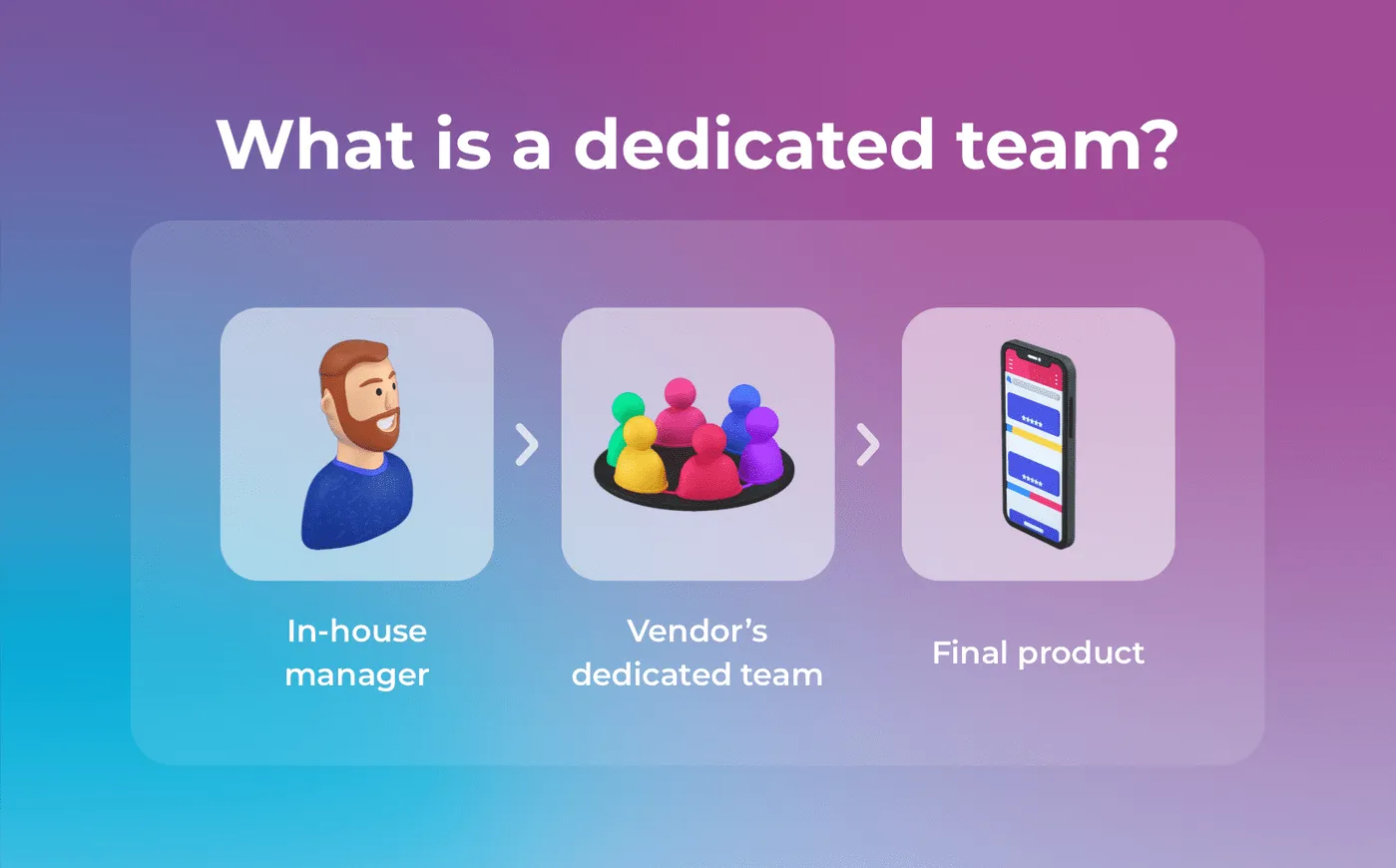
The dedicated team concept
How Does It Work?
Let’s figure out what stands behind the dedicated team model. Underneath, you can see stages that you go through as a client choosing a tech partner.
Requirements
At this stage, you should clearly define your requirements and expectations. Business analysts gather this information to assemble the right team. In case you don’t have technical expertise, a company’s business analysts and engineers should help you draw up a feature list, figure out the tech stack, and make a rough estimate of your future project.
Need to clarify project requirements?
Our business analysts and engineers are ready to consult you about your project.
Price negotiation
Once requirements are clear, the vendor defines what dedicated team structure is needed to deliver the project. Here’s an example of a dedicated team:
- Business analyst
- UI/UX designer
- QA engineer
- Mobile developer
- Back-end developer
- DevOps
- And others
At this stage, you negotiate the price, payment frequency, and duration of the contract. Price flexibility is one of the main advantages of a dedicated team model, which we’ll cover later on.
Assembling the team
After requirements and price are clear, the vendor starts assembling the team. The length of this process depends on how many developers you need. If you have a small project that requires several developers, chances are you get them by the next day.
However, if the project requires 20-30 developers, the company may not have that much at the moment. In that case, you’ll have to wait until other engineers become vacant or the company hires new specialists. It sounds like a long process, yet it’s still cheaper and faster than looking for developers by yourself (unless you have a team of experienced IT recruiters).
Onboarding the team
After assembling the team, it’s time to introduce the team to your project. Now, your task is to establish a communication bridge with a dedicated team, introduce remote specialists to your in-house team, explain how your corporate software works, and tell them about the workflow. Besides, it’s important to appoint an employee responsible for specifying the frequency of reports from a team and working those reports.
Getting to work
When everything is done, your new employees start on the project. Now the main task is to control and manage the process.
Dedicated Team Advantages
As you now know what dedicated teams are, it’s high time to outline the benefits of this model.
Cost-Effectiveness
If you’re a resident of the US, Central, Western Europe, or Oceania, it’s doubtful that you’ll find a better value for money. According to PayScale, a senior software engineer in the US charges $64/hour. This price is approximate and depends on technologies this specialist works with. If it’s a senior data scientist with deep expertise in machine learning and related technologies, the rate may reach up to $100/hour and over.
Mind that a single developer can’t build you a project, so you’ll have to gather a team. Even though junior developers charge far less, an in-house team of ten developers will cost you a lot of money.
In this guide, we’ve calculated cost to outsource app development and highlighted the most cost-effective options
With dedicated teams, your expenses decrease drastically. In Ukraine, one of the most popular outsourcing destinations, developers’ hourly rates lie in the range of $25-37/hour. That’s almost four times cheaper than in the US.
Besides, with a dedicated team model, you don’t have to expand your office for new employees because they work remotely. Other expenses like hardware, software, social package, recruiting also fall onto the vendor’s shoulders.
Hassle-Free Recruiting
One of the dedicated team advantages is that a vendor assembles the team according to your project requirements. You can also request CVs of all candidates if needed. If there's no required specialist in-house, the vendor side will recruit a specialist for this position as fast as possible.
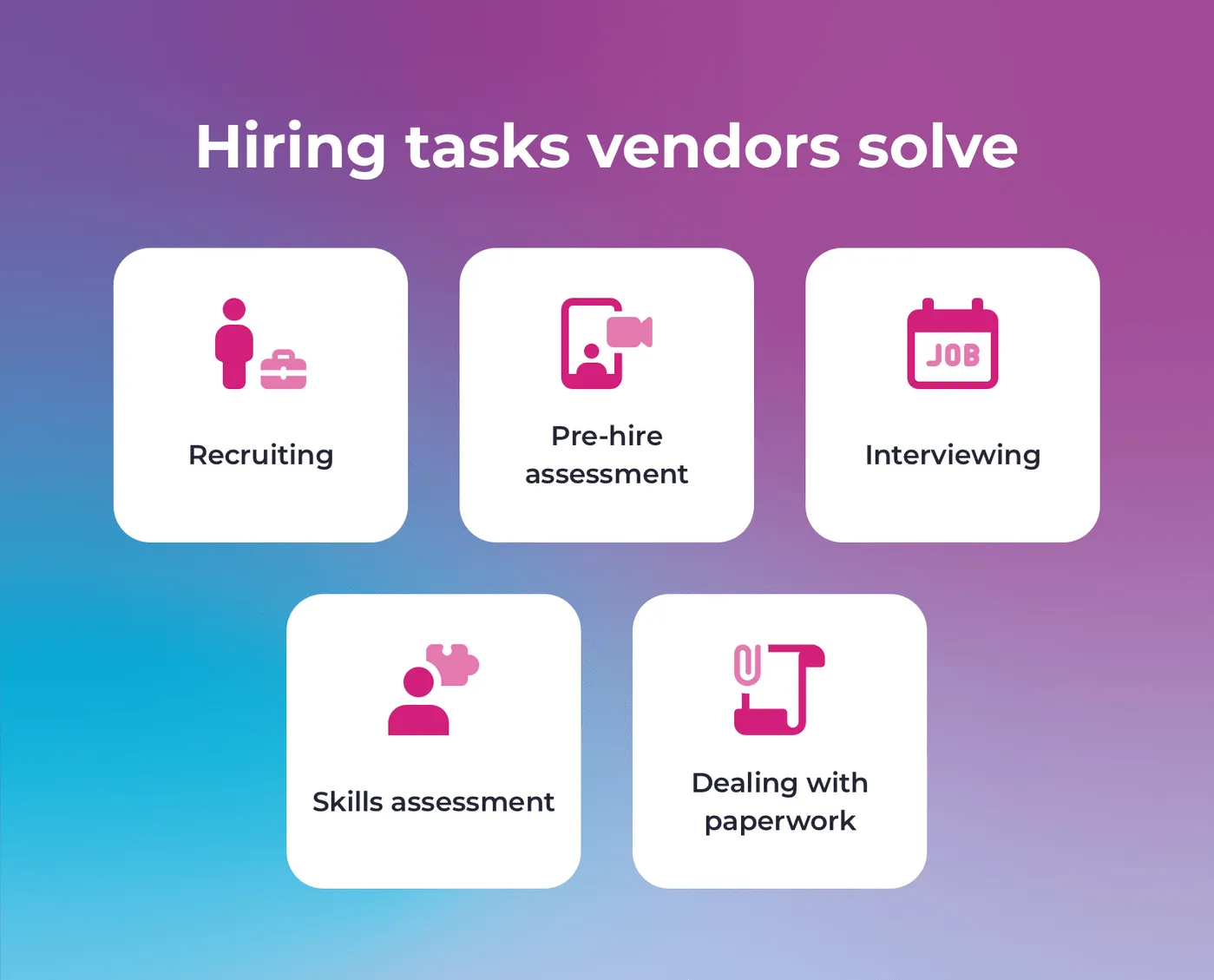
Five hiring tasks solved with the help of the dedicated team model
So, you don’t waste your time and money on recruiting (which in some cases may be unsuccessful).
Team Management
A dedicated team is flexible when it comes to project management. Let’s assume that you’re a skilled programmer with vast experience. With this model, you can take over project management responsibilities and be in charge of the project.
In case you’re hiring a dedicated team for a side project or to take the load off your core team, you can entrust the project to the project manager from your office. An experienced PM from your side will communicate with a dedicated team and keep you updated.
If you don’t have such an employee in your office, you can hire a PM right from your vendor. Project managers from outsourcing companies have fluent written and spoken English and know how to manage projects. What’s most important is that the vendor’s PM is a part of the dedicated team. They’re often in one office with developers and so can manage them faster.
Cultural Fit and Corporate Ethics
Cultural fit is among the benefits of a dedicated team model. Even though dedicated teams work remote-only, they are still a part of the vendor's company. As any business, software development companies choose only the best employees not only looking at hard skills but also paying attention to soft skills. Dedicated team members are great team players, know how to stay productive, motivated, and not lose focus from their tasks.
Cons of Dedicated Teams
Even though a dedicated team model looks like an affordable all-purpose development approach, it has its own flies in the ointment. Let’s discover the major drawbacks of the dedicated team model.
Remote Management Issues
Even if you’re a self-sufficient project manager understanding the software development workflow, you should realize the amount of work required to control a remote team. Regular online meetings with a dedicated team and constant feedback require a high level of dedication from the manager.
Most likely, it’s a bad idea to combine project management and other tasks that you have to deal with as a product owner. Project management is a time-consuming work that doesn’t leave much space for multitasking.
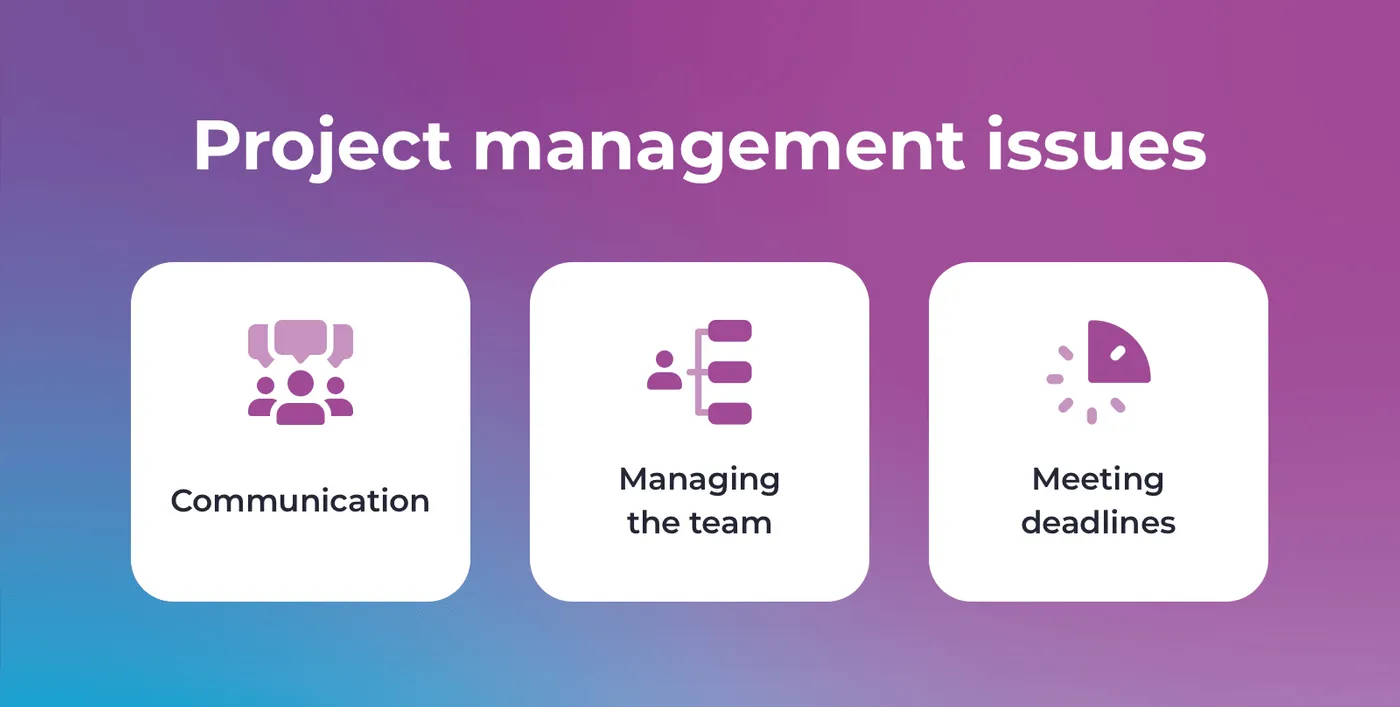
Three issues that project managers should be aware of
If you don’t have an experienced manager, your tech partner can include one to your team. Outsourced managers work in the same office as the dedicated team, so it’s easier for them to discuss project details and organize the workflow. Besides, they know how to use software development approaches to get things done on time.
Short Projects Are a No Go
One of the dedicated team’s advantages is speed, but it still takes time to gather developers for a project. Team assembling, establishing communication, getting used to new tools, and workflow can be too long for a short project.
When the Dedicated Team Works and When Doesn’t
A dedicated team is a versatile model that can solve a lot of businesses’ software-related issues. However, there are some exceptions that require you to use other outsourcing models.
It’s time to learn when dedicated teams are the best option.
When It Works
1. Large projects
Large-scale projects are the most common use case for dedicated teams. If you have strict time frames or a talent shortage, a dedicated team can solve your problem. Additional specialists will fill the gap and take care of the part of the development process. Thus, you take the workload off of your developers and boost the process.
2. An unexpected shift of priorities
Software development trends don’t stand still, and startups often change the development vector right in the middle of the process. If you’ve decided to add new features or even redesign the project completely, you’ll have to waste more time on the development. Dedicated teams can make the project more time-efficient and reach objectives before the deadline.
3. Tight budget
Money is the main driving force of the project. As it was said before, dedicated teams are far more cost-efficient than in-house developers. If you’re on a budget, you have to decide whether you’ll cut the expenses by reducing the number of features or hiring fewer developers. A dedicated team model can help you keep the balance due to the lower price. Thus, you get a project that meets initial requirements without cutting corners on the features.
When It Doesn’t Work
1. Small projects
There’s no point in assembling a dedicated team for too short projects. If you have an idea for a mini-project, you can hire several freelancers or stand-alone programmers. You won’t feel the price difference compared to software outsourcing, but you’ll save a lot of time on searching for the company that will help you.
2. Side projects
If you’re running side projects in addition to the one you want to outsource, a dedicated team model won’t suit your needs. A remote team requires constant feedback and management on the client’s side. If dedicated developers don’t get responses from an in-house team, they feel left-alone and fall out of the project. It’s crucial to remember that software development revolves around teamwork. That’s why you have to make sure that nothing holds you or your managers from communication with a remote team.
3. Your in-house team doesn’t want to cooperate
This point recalls the previous one. In-house developers often feel superior to remote developers. They were at the origins of the project and feel more privileged than hired developers. However, it’s important to reach out to your employees that even if a dedicated team is several time zones away from the office, they’re still part of the company for the term of the contract. That’s why they should be treated with the same respect as anyone else in the company.
If you notice that your employees don’t seem very happy with this idea, it’s better to think about other options to avoid misunderstandings and resentments in the future.
Comparing Dedicated Team With Other Models
Outsourcing isn’t only about dedicated teams. There are more models that can be suitable for other project types and situations. The most popular approaches are Time & Material and Fixed price models. In this section, we’ll discuss their advantages and pitfalls compared to a dedicated team model.
Dedicated Team vs. Fixed Price
With the Fixed Price model, you’ll know the project cost from the very beginning of the project. When business analysts draw up project specifications, no changes can be made during the development.
This strategy puts all the risks on your tech partner. If estimates were incorrect and the project needs more development time, then the software development company takes all the expenses on itself. To avoid risky situations, you have to describe your requirements and project goals very clearly.
With a dedicated team model, you pay salaries of team members and a company fee during the entire contract. Even if the project was completed before the contract's expiry, you still have to pay salaries to dedicated developers. That’s why it’s crucial to clarify all requirements and project details to estimate the development time precisely.
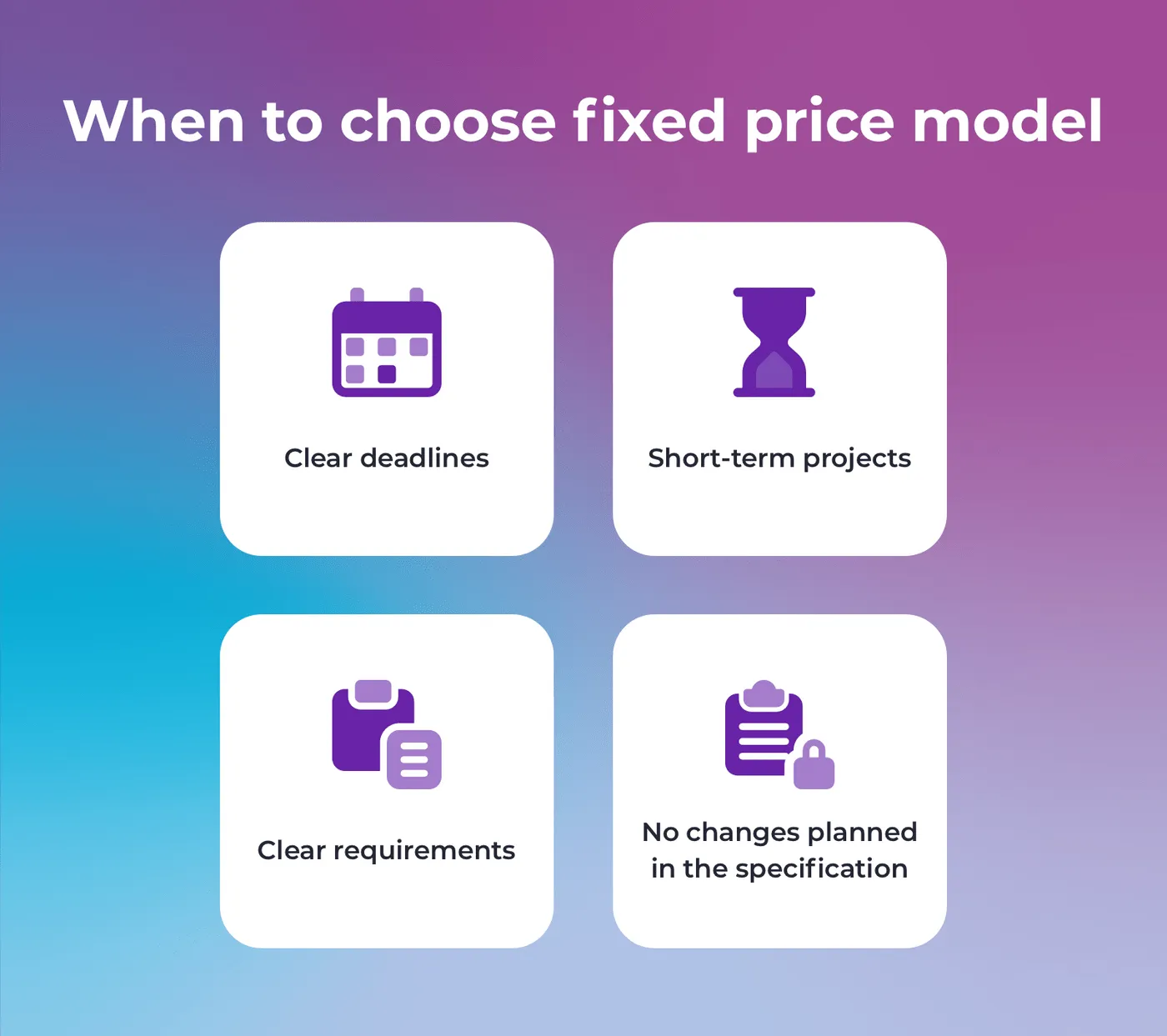
Top reasons to choose fixed price model
It’s important to understand that this model suits for short-term cooperation when the project doesn’t have many unknown variables. And because you can’t make changes during the development, this model is considered to be the least flexible of all. On the other hand, if you have a small project and a small budget, this model is the best choice for you. You can understand all the expenses from the start and allocate the rest of the resources for marketing or sales operations.
Dedicated Team vs. Time and Material
A Time & Material model implies payments for the time spent on the project. The cost of the project is calculated with the following formula:
Project price = Number of hours spent on the project * Developers’ hourly rate ($/hour)
For example, if you’ve signed a contract with the company that charges $50/hour and the time spent on the project was 1,000 hours, then the final project price will be $50,000. However, the work of business analysts, designers, DevOps cost money too. You can add and remove specialists according to your budget. That’s why Time & Material is a flexible model for projects with shifting requirements.
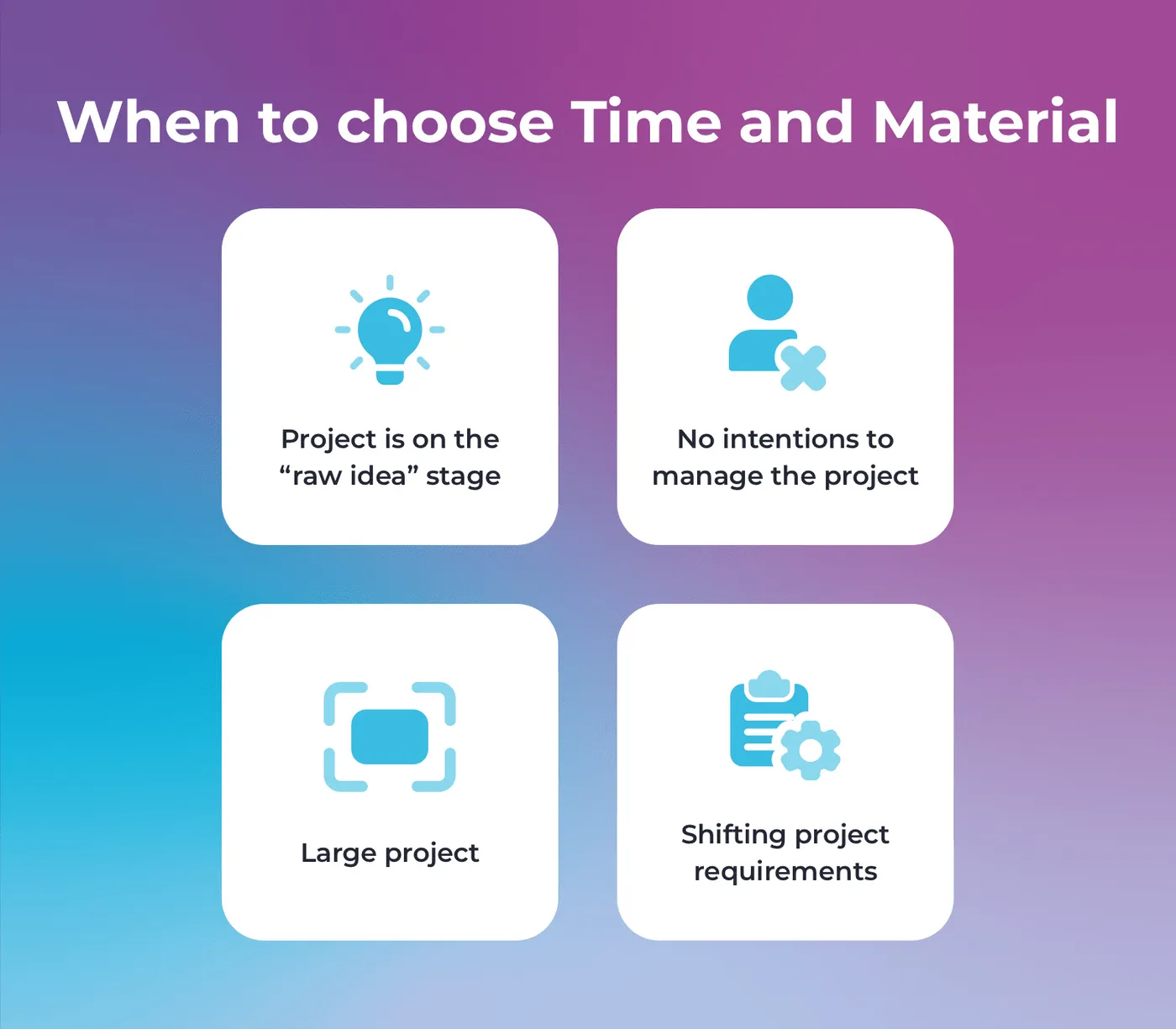
Four reasons to go for a Time and Material model
Learn how Time and Material works and what benefits businesses get from this model
Where to Find and Hire Dedicated Teams
IT outsourcing became so popular that today there exist a ton of resources to find a reliable tech partner. Services like Clutch provide basic information about the company and client reviews so that other potential clients can assess the company’s experience and reliability. Here’s the list of the most popular services where you can find a dedicated team.
- Clutch. Clutch is one of the most famous platforms that stores information about various software development vendors. Here you can access data about company’s size, minimal project price, companies’ location, and so on. In the description, businesses always specify the services they provide like AR development, DevOps services, dedicated teams. On top of that, you can check clients’ reviews and the position in the global ranking.
- GoodFirms. GoodFirms is another platform that helps companies to choose a software development vendor. It has in-built filters that divide specialists according to their specialization. The platform also creates reports in different fields and industries that may be useful while searching for a tech partner.
- IT Firms. This platform draws up lists with the best software developers in different regions. You can use IT Firms to exclude weak candidates and keep only the best ones.
Top Outsourcing Destinations
While choosing a dedicated team, you should be aware of software development rates in different regions. American vendors charge far more than similar companies from Eastern Europe, for example. The difference in rates results from developers’ salaries and the cost of living in a particular country.
We’ve prepared a comparative table with rates in the most popular outsourcing destinations:
| Country | Average rate | Companies | Talents | English level |
Ukraine | $37/h | 278 companies | 192 | 52,13 |
Poland | $40/h | 181 companies | 280 | 63,76 |
Brazil | $51/h | 112 companies | 300 | 50,1 |
India | $25/h | 831 companies | 2,700,000 | 55,49 |
United Kingdom | $71/h | 272 companies | 849 | Native |
Mind that you don’t have to fall for the lowest project cost. An attractive hourly rate doesn’t always reflect the quality of software development services. Conduct detailed research of software vendors and make inquiries about each company with the help of services we’ve advised. Thorough preparation will save your money and get you an outstanding dedicated team.
Here’s our guide on hiring offshore software developers. We’ve revealed the best outsourcing destinations and covered developers’ rates.
How Can Cleveroad Help You?
Our clients often need new specialists to supplement their projects. We know how to gather dedicated teams that get work done and deliver quality software in the shortest terms. Our project managers always keep you informed about the progress and know how to effectively manage a team following the latest practices. We’ve delivered more than 150 successful projects, both for startups and large companies. Check our portfolio to learn more.
Looking for talents?
We can pick the best specialists for your project based on your business goals and requirements.
A dedicated team model is an approach where clients hire a team of developers for their projects. It’s usually a team managed from the customer side. Still, some companies offer hiring a project manager from their side.
A dedicated team model implies hiring a team of developers and gives an opportunity to manage the team on your own. With other models the team will be managed by the vendor's project manager. The product owner will only have an information about the project condition.
The staff augmentation model implies exclusively supplementing your in-house team with new developers. The dedicated team model, in its turn, can be used to hire a full team of remote developers and manage it on your own. So, if you don't have your own team - a dedicated team model is your best option.
Here's a list of the dedicated team model's benefits:
- Cost-effectiveness
- Hassle-free recruiting
- Team management
- Cultural fit and corporate ethics
When choosing a dedicated team you should pay attention to the vendor's company. Analyze the reviews on various platforms and ask about the company's previous experience.
With dedicated team you can manage developers on your own. You pay salaries of team members and a company fee during the entire contract. Even if the project was completed before the contract's expiry, you still have to pay salaries to dedicated developers.
With the Fixed Price model, you’ll know the project cost from the very beginning of the project. When business analysts draw up project specifications, no changes can be made during the development.
A Time & Material model implies payments for the time spent on the project. For example, if you’ve signed a contract with the company that charges $50/hour and the time spent on the project was 1,000 hours, then the final project price will be $50,000.

Evgeniy Altynpara is a CTO and member of the Forbes Councils’ community of tech professionals. He is an expert in software development and technological entrepreneurship and has 10+years of experience in digital transformation consulting in Healthcare, FinTech, Supply Chain and Logistics
Give us your impressions about this article
Give us your impressions about this article
Comments
4 commentsGreat article
The post is brilliant. There's a ton of articles about th dedicated team model, but this one managed to highlight everything from the concept to the comparison of various models. Thank you!
I should admit that we often hire dedicated developers to boost the development process of new projects. This model really helps to take the load off the core team and save some money.
Top-notch content! Many THANKS!